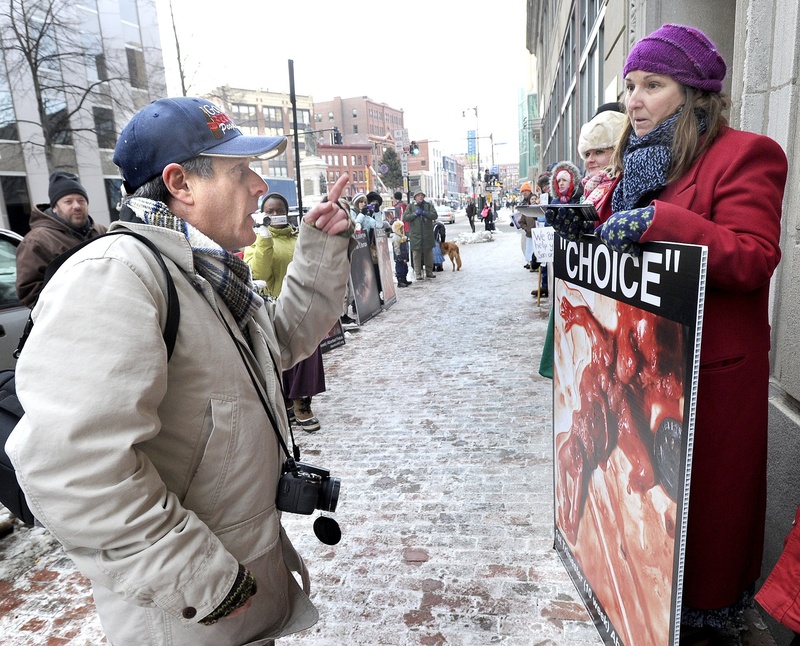PORTLAND – City councilors decided Tuesday to schedule a hearing on a proposal to shield women from protesters who gather outside the Planned Parenthood offices downtown.
The city is proposing a 39-foot buffer zone around two entrances to Planned Parenthood, on Congress and Elm streets, where anti-abortion protesters would be banned.
The council’s Public Safety, Health and Human Services Committee took no public comment at Tuesday’s meeting, but more than a dozen supporters of the buffer zone listened to the deliberations. Many wore pink T-shirts saying “I stand with Planned Parenthood.”
“We are very pleased with the direction where the committee is going,” said Eric Covey, a community organizer with Planned Parenthood, after the meeting. “Every Friday and Saturday, patients are being harassed and intimidated. This is an issue that is continuing and we need to address it.”
The committee, which was supportive of the proposal, scheduled the public hearing for Oct. 8, when it will likely vote on a recommendation to the full council.
For about a year, 10 to 25 anti-abortion protesters have gathered regularly in front of Planned Parenthood’s Congress Street entrance in an effort to dissuade women from getting abortions, which are offered there.
Protesters, including children, hold large signs showing graphic photos of aborted fetuses. Some shout Bible verses at women and call women murderers as they enter the building.
Planned Parenthood has been collecting testimonials from patients who have said they felt threatened and harassed by “the gauntlet” of protesters. Some women have indicated that they could hear protesters from inside the building.
Donna Hebert, a lead organizer of the protesters, said in a phone interview after Tuesday’s meeting that she would seek legal help to fight against the buffer zone if it is enacted. In the meantime, the protesters won’t be discouraged from continuing to speak their minds, she said.
“They’re pushing us across the street and trying to silence us,” Hebert said. “We still have our freedom of speech. We’re there for the unborn babies, who have no voice. We’ll just hold bigger signs and shout a little louder.”
Hebert and another protest organizer, Leslie Sneddon, have said they had multiple abortions before becoming Christians and deciding to stop other women from making the same decisions.
The committee first considered the proposed buffer zone in July. Members expressed a desire to move slowly on any buffer zone and said it should balance a patient’s right to receive health care with protesters’ freedom of speech.
Police Chief Michael Sauschuck said Tuesday that protesters, who gather on Friday and Saturday mornings, have not broken any laws, and that protests have been “status quo” in terms of numbers and complaints from patients.
Trish McAllister, Portland’s neighborhood prosecutor, told the committee that a narrowly crafted ordinance establishing a 39-foot buffer zone along Congress and Elm streets would survive a legal challenge, based on existing case law.
A memo from McAllister to the committee cites several cases in which some sort of buffer zone — whether an 8-foot “bubble” around the patient or a larger buffer zone measured from the building entrance — has been upheld by courts.
“Our legal opinion is that it does pass constitutional muster based on the case law that exists,” McAllister said. “The concern is the Massachusetts case.”
The U.S. Supreme Court will take up a challenge to a Massachusetts law that creates a 35-foot buffer zone around entrances to “places where abortions are performed,” other than hospitals.
The First Circuit U.S. Court of Appeals upheld a district court ruling that the law is constitutional, according to McAllister’s memo.
“This (Massachusetts law) is very similar to the one that is proposed here,” she wrote.
The court cases cited in the memo apply to buffer zones of 15 to 35 feet, but a 35-foot zone in front of Planned Parenthood would leave a small area on Congress Street available to protesters, so it was extended by 4 feet, McAllister said.
The 39-foot buffer could leave a small area on Elm Street where protesters could gather, so the committee directed the city’s staff Tuesday to expand the zone to eliminate that area.
Although McAllister said the city has a strong case should any buffer zone be challenged in court, a U.S. Supreme Court ruling against the Massachusetts law would void Portland’s ordinance, she said. “There’s no doubt about it.”
Committee members told people in the crowd that the city is methodically building a public record that includes patients’ testimony, police actions and committee deliberations so the buffer zone can withstand a court challenge.
“You clearly drafted this with great caution,” said Councilor Jill Duson. “I like this.”
Also Tuesday, the committee unanimously recommended changes to the city’s regulations for food trucks to make it easier to do business in Portland.
The changes would allow food trucks to cluster in certain zones by eliminating a rule that trucks be at least 65 feet from each other. And operators would have to pay only $30 for a permit to operate on private property, rather than $105.
The committee also was open to the idea of opening up more city-owned land to food truck operators, including Compass Park, the Eastern Promenade and the Western Promenade, but requested more details from city staff.
Randy Billings can be contacted at 791-6346 or at:
rbillings@pressherald.com
Twitter: @randybillings
Send questions/comments to the editors.



